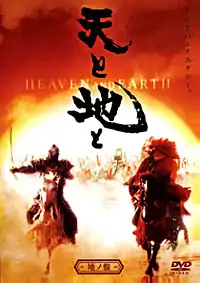| Heaven and Earth Ten to Chi to | |
|---|---|
 DVD Cover | |
| Directed by | Haruki Kadokawa |
| Written by | Haruki Kadokawa Toshio Kamata Chogoro Keynji Isao Yoshiwara |
| Produced by | Yutaka Okada |
| Starring | |
| Music by | Daisuke Hinata Tetsuya Komuro |
| Distributed by | Toei Company |
Release date |
|
Running time | 104 minutes |
| Country | Japan |
| Languages | Japanese English |
| Budget | ¥5 billion[2] |
| Box office | ¥9.2 billion (Japan) $307,775 (United States) |
Heaven and Earth (天と地と, Ten to Chi to) is a 1990 Japanese film, directed by Haruki Kadokawa and starring Takaaki Enoki, Tsugawa Masahiko, Asano Atsuko, Zaizen Naomi and Nomura Hironobu.[3] The film was released in Japan in June 1990, and an English version was released in North America in 1991.
Ken Watanabe was originally cast in the role of Kenshin but had to pull out due to his severe illness.[4]
Plot
Set in feudal Japan, the daimyō Kagetora (Enoki) must protect his lands and his people from the ambitions of the warlord Takeda (Tsugawa).
Kagetora is also known as Uesugi Kenshin. In the film, Kagetora must defend his province of Echigo against Takeda Shingen. The famous battles include the Battle of Kawanakajima.
Cast
- Takaaki Enoki as Uesugi Kenshin
- Masahiko Tsugawa as Takeda Shingen
- Atsuko Asano as Nami
- Naomi Zaizen as Yae
- Hironobu Nomura as Takeda "Tarō" Yoshinobu
- Taro Ishida as Takeda Nobushige
- Binpachi Itō as Kakizaki Kageie
- Akira Hamada as Naoe Kagetsuna
- Hiroyuki Okita as Kōsaka Danjō
- Hideo Murota as Obu Toramasa
- Isao Natsuyagi as Yamamoto Kansuke
- Tsunehiko Watase as Usami Sadayuki
- Morio Kazama
- Masatō Ibu
- Kyōko Kishida
- Hideji Ōtaki
- Tomomichi Nishimura as Narrator
Production
Heaven and Earth was the most expensive Japanese production at the time with a budget of $40 million. The film was shot largely in Canada and was in production for a year and featured 1,000 horses and 3,000 extras.[1]
Reception
In Japan, Heaven and Earth had sold 4.8 million tickets in pre-sales prior to release.[5] It opened on 23 June 1990 on 215 screens in Japan and grossed $8.4 million, one of the largest openings in Japan at the time.[1] It became the number-one Japanese film on the domestic market in 1990, earning ¥5.05 billion in distributor rental income[6] and ¥9.2 billion in gross receipts.[7] In the United States, the film grossed $307,775.[8]
References
- 1 2 3 Fleming, Charles (15 August 1990). "Kadokawa's samurai pic heavenly at B.O.". Variety. p. 39.
- ↑ Shimbun Akahata (in Japanese). Vol. 30, no. 354. Japanese Communist Party. 1990. p. 326.
{{cite magazine}}: Missing or empty|title=(help) - ↑ 山根貞男『映画はどこへ行くか 日本映画時評'89-'92』 1993) ISBN 4-480-87220-5 p. 74
- ↑ "Takaaki Enoki profile". 映画DB. Retrieved 2 October 2021.
- ↑ "Kadokawa Haruki". The Encyclopedia of Science Fiction. 5 August 2020. Retrieved 13 April 2022.
- ↑ "Kako haikyū shūnyū jōi sakuhin 1990-nen" (in Japanese). Motion Picture Producers Association of Japan. Retrieved 5 February 2011.
- ↑ "歴代ランキング" [All-time box office top 100]. CINEMAランキング通信. Kogyo Tsushinka. Archived from the original on 10 June 2012. Retrieved 23 May 2020.
- ↑ "Битва самураев (Ten to Chi to, 1990)". Kinopoisk. Retrieved 20 March 2022.
External links